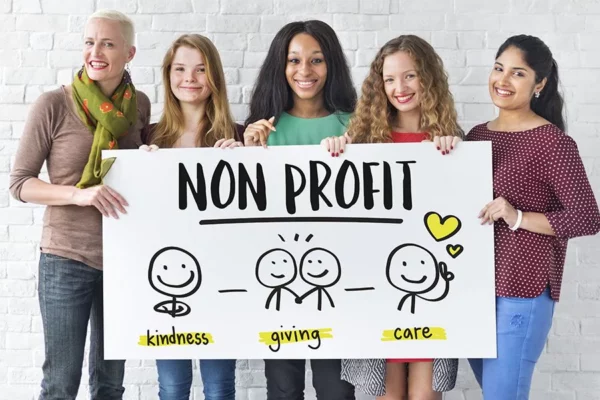Influencer marketing for nonprofits is a great strategy if you are looking to increase awareness of your nonprofit’s mission. By partnering with social media influencers, you can reach a wider audience and gain more support for your cause. Influencer marketing for nonprofits has been around for a while, but social media has made it more accessible and effective than ever before.

The basic concept of influencer marketing for nonprofits is simple: you collaborate with someone who has a large following on social media to promote your nonprofit. This person, known as an influencer, could be a celebrity, a social media personality, or just someone with a lot of followers who are interested in your cause. By working with an influencer, you can tap into their audience and gain exposure for your nonprofit in a way that might not be possible through traditional marketing methods.
Influencer marketing for nonprofits can be a powerful tool, especially for organizations with limited resources. By partnering with the right influencers, you can reach a wider audience and gain more support for your mission. However, it’s important to approach influencer marketing for nonprofits strategically and with a clear plan in place. In the following sections, we’ll explore some tips and best practices for using influencer marketing to promote your nonprofit.
Understanding Influencer Marketing
Influencer marketing has become a popular strategy for nonprofits to reach new audiences and increase awareness of their cause. In this section, we will explore the role of influencers in nonprofit awareness and how to choose the right social media platforms.

The Role of Influencers in Nonprofit Awareness
Influencers are individuals who have a significant following on social media and are seen as experts or authorities in their niche. In influencer marketing for nonprofits, you can tap into the reach and credibility of influencers to promote your cause and increase awareness.
Influencers can help nonprofits in several ways, including:
- Reach: Influencers have a large following on social media, which means they can help nonprofits reach a wider audience than you would be able to on your own.
- Trust: Influencers have built a relationship of trust with their followers, which means their recommendations are more likely to be taken seriously.
- Awareness: Influencers can help increase awareness of a nonprofit’s cause by sharing your message with their followers.
When working with influencers, it’s important to choose someone who is aligned with your nonprofit’s values and mission. Look for influencers who are passionate about your cause and have a genuine interest in helping you succeed.
Choosing the Right Social Media Platforms

When it comes to influencer marketing, not all social media platforms are created equal. Different platforms have different audiences and engagement rates, which means you need to choose the right ones for your nonprofit.
Here are some things to consider when choosing social media platforms for your influencer marketing campaign:
- Audience: Look for platforms that have a large following of people who are interested in your cause.
- Engagement: Look for platforms where influencers have a high engagement rate, which means their followers are more likely to take action.
- Relevance: Look for platforms that are relevant to your cause and where your nonprofit can share its message effectively.
Some popular social media platforms for influencer marketing include Instagram, YouTube, and TikTok. However, it’s important to do your research and choose the platforms that are right for your nonprofit and your target audience.
Developing a Strategy for Nonprofit Influencer Campaigns
Influencer marketing for nonprofits can help you increase your impact and reach. Developing a strategy for nonprofit influencer campaigns involves setting clear goals and objectives, identifying and engaging with relevant influencers, and crafting a compelling campaign message.
Setting Clear Goals and Objectives

Before launching an influencer campaign for your nonprofit, it’s important to set clear goals and objectives. This can help ensure that the campaign is aligned with the nonprofit’s values and mission and that it will have a measurable impact. Some common goals for nonprofit influencer campaigns include:
- Raising awareness of the nonprofit’s mission and impact
- Increasing donations or volunteer sign-ups
- Building relationships with potential partners or donors
- Encouraging advocacy or social change
Identifying and Engaging with Relevant Influencers
Identifying and engaging with relevant influencers is a critical part of any influencer campaign. As a nonprofit, you should look for influencers who share your values and have a genuine interest in your cause. Some ways to identify potential influencers include:
- Searching social media platforms for relevant hashtags or keywords
- Looking for influencers who have supported similar causes in the past
- Reaching out to existing supporters or volunteers who have a strong social media presence
Once potential influencers have been identified, it’s important to engage with them in a way that is authentic and respectful. As a nonprofit, you should aim to build a relationship with influencers over time, rather than simply asking them to promote your cause.
Crafting a Compelling Campaign Message

Crafting a compelling campaign message is key to the success of any influencer marketing for nonprofits. You should aim to create a message that is clear, concise, and resonates with your target audience. Some tips for crafting a compelling campaign message include:
- Highlighting the nonprofit’s impact and achievements
- Using storytelling to make the message more relatable
- Including a clear call-to-action that encourages people to take action
By setting clear goals and objectives, identifying and engaging with relevant influencers, and crafting a compelling campaign message, nonprofits can create successful influencer campaigns that have a real impact.
Building and Nurturing Influencer Relationships
Similar to other digital marketing strategies, influencer marketing is a powerful tool for nonprofit organizations to spread awareness, build trust, and attract donations and volunteers. However, it’s not just about finding the right influencer for your cause. Building and nurturing relationships with influencers is key to long-term success.
Fostering Long-Term Partnerships
To build a successful influencer marketing campaign, it’s essential to foster long-term partnerships with influencers. This means going beyond a one-time collaboration and investing in a lasting relationship. To do this, you need to identify influencers that share your values and align with your mission.

Once you’ve identified potential influencers, start by engaging with them on social media. Like, comment, and share their content to show your support. Reach out to them directly and introduce yourself and your organization. Ask them about their interests and goals, and find ways to collaborate that benefit both parties.
To foster a long-term partnership, it’s important to provide value to your influencers. This could mean sharing exclusive content, providing early access to events, or offering other perks that make them feel appreciated and valued. By building a strong relationship with your influencers, you’ll create a loyal advocate for your cause.
Engagement and Communication Tactics
Engagement and communication are critical components of building and nurturing influencer relationships. It’s important to establish clear expectations and guidelines for your influencers, so they know what’s expected of them. This could include guidelines for content creation, social media posting, and event attendance.
Regular communication is also key to building a lasting relationship with your influencers. Keep them updated on your organization’s activities, and ask for their input on new initiatives. Show them that their opinions and ideas matter, and that you value their feedback.
Finally, it’s important to be transparent and honest with your influencers. Don’t make promises you can’t keep, and be upfront about any limitations or challenges you’re facing. By building trust and transparency with your influencers, you’ll create a strong foundation for a successful influencer marketing campaign.
Related Posts:
Measuring the Impact of Influencer Collaborations
When it comes to influencer collaborations, measuring the impact of your campaign is crucial to determine its success. Measuring the return on investment of influencer marketing campaigns can help you understand the effectiveness of your strategy and identify areas for improvement.

Key Performance Indicators (KPIs) and Metrics
Key Performance Indicators (KPIs) and metrics are essential tools for measuring the impact of influencer collaborations. KPIs are measurable values that indicate how well you are achieving your goals. Metrics are quantifiable data points that provide insight into the performance of your campaign.
Some common KPIs and metrics for measuring the impact of influencer collaborations include:
- Awareness: Measuring the reach and impressions of your campaign can help you determine how many people were exposed to your message. This can be done by tracking the number of followers, likes, shares, and comments on social media platforms.
- Engagement Rates: Engagement rates can help you determine how many people are actively engaging with your content. This can be measured by tracking the number of likes, comments, shares, and click-through rates.
- Conversions: Conversions are the ultimate goal of any influencer marketing campaign. This can be measured by tracking the number of clicks, sales, or sign-ups generated by your campaign.
Analyzing Campaign Effectiveness
Analyzing the effectiveness of your influencer marketing campaign is essential to determine its success. Here are some tips for analyzing your campaign effectiveness:
- Track Your KPIs and Metrics: Tracking your KPIs and metrics can help you determine the effectiveness of your campaign. This can be done by using analytics tools such as Google Analytics, Hootsuite, or Sprout Social.
- Compare Your Results: Comparing your results to your goals can help you determine how well you are achieving your objectives. This can be done by comparing your KPIs and metrics to your initial goals and benchmarks.
- Identify Areas for Improvement: Identifying areas for improvement can help you optimize your campaign for better results. This can be done by analyzing your KPIs and metrics to determine which areas of your campaign are underperforming and need improvement.
By measuring the impact of your influencer collaborations, you can optimize your campaign for better results and achieve your goals more effectively.
Leveraging Influencer Content for Fundraising Efforts

Influencer marketing can be a powerful tool for nonprofits to increase awareness, drive donations, and expand your audience. By partnering with influencers, you can tap into their engaged followers to promote your nonprofit’s campaigns and mission. In this section, we will explore how nonprofits can leverage influencer content for fundraising efforts.
Integrating Influencer Outreach in Fundraising Plans
Integrating influencer outreach in your fundraising plans can help you reach a wider audience and increase donations. Start by identifying influencers whose values align with your nonprofit’s mission. Once you have identified potential influencers, reach out to them with a personalized message that explains why you are interested in working with them and how they can help your cause.
Consider offering influencers a unique opportunity to create content that promotes your nonprofit’s mission. This could include a sponsored post on their social media channels or a blog post on their website. By giving influencers creative control over the content, they can create content that resonates with their audience and drives engagement.
Creative Approaches to Influencer-Driven Fundraisers
In addition to promoting your nonprofit’s mission, influencers can also help drive fundraising efforts. Consider partnering with influencers to create a unique fundraising campaign that encourages their followers to donate to your cause. For example, you could create a challenge that encourages followers to donate a certain amount of money in exchange for the influencer completing a specific task.
Another creative approach is to host an influencer-driven fundraiser event. This could include a charity auction or a virtual event that features influencers as special guests. By leveraging the influence of these individuals, you can create a memorable event that drives donations and raises awareness for your nonprofit’s mission.

In conclusion, leveraging influencer content for your nonprofit marketing efforts is a great way to increase awareness, drive donations, and expand your audience. By integrating influencer outreach in your marketing plans and partnering with influencers to create unique fundraising campaigns, you can make use of their engaged followers to promote your nonprofit’s mission.



